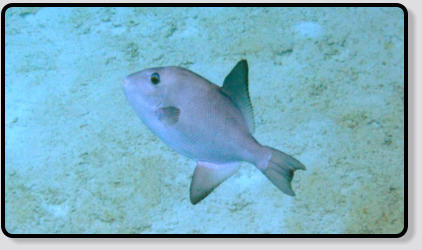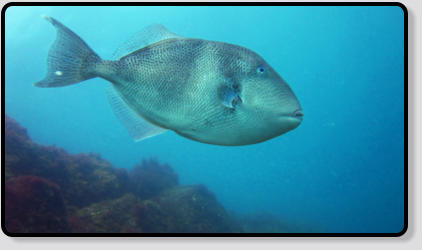Scientific classification
Kingdom:
Phylum:
Chordata
Class:
Actinopterygii
Order:
Tetraodontiformes
Family:
Balistidae
Genus:
Balistes
Species:
C. Sufflamen
Canthidermis Sufflamen
Binomial name




Ocean Triggerfish
Baliste Océanique
Ozean-Drückerfisch
Gallo Oceánico
Oceaan Trekkervis

Description
Length: up to 55 cm.
Habitat: coastal pelagic..
No further information available on Wikipedia.

Animalia
Scientific classification
Kingdom:
Phylum:
Chordata
Class:
Actinopterygii
Order:
Tetraodontiformes
Family:
Balistidae
Genus:
Balistes
Species:
B. Capriscus
Binomial name (link Wikipedia)




Grey Triggerfish
Baliste Bleu
Grauer-Drückerfisch
Gallo Cochino
Grijze Trekkervis

Description
Length: up to 50 cm.
Habitat: Rocky bottom. It also pelagic, under floating objects.
The grey triggerfish is a medium-sized fish that can grow to 60 cm (24 in), but a more common length is 44 cm (17 in). The small beak-like mouth
at the tip of the snout has fleshy lips. The eyes are set far back near the top of the head. The body is laterally compressed and deep-bodied with
a tough, leathery skin. The front dorsal fin has three spines, the first being very strong and much longer than the other two. The second dorsal fin
has 26 to 29 soft rays and is much the same size and shape as the anal fin directly below it which has no spines and 23 to 26 soft rays. The
pectoral fins are small and rounded. The outer rays of the caudal fin are elongated in larger individuals. The scales on the head and front half of
the body are large while those on the hind half are smaller and smooth.
This fish is predominantly pale grey, greenish-grey or yellowish-brown. The body has three indistinct broad dark bars and there is a pale streak
on the chin. The upper part of the orbit of the eye is blue and there are some small blue spots and lines on the dorsal fins and upper parts of the
body, and sometimes white dots and irregular lines on the lower parts of the body. Both the second dorsal and the anal fin present a somewhat
marbled appearance. The body colour fades a little as the animal gets older: juveniles are more colourful.
Animalia
Scientific classification
Kingdom:
Phylum:
Chordata
Class:
Actinopterygii
Order:
Perciformes
Family:
Scaridae
Genus:
Sparisoma
Species:
S. Cretense
Binomial name (link Wikipedia)




Parrotfish
Poisson Perroquet
Papageifisch
Vieja
Papegaaivis

Description
Length: up to 50 cm (the are usually smaller in the western Canary
Islands).
Habitat: Rocky bottom and rocky with seaweed.
The Mediterranean parrotfish (Sparisoma cretense) is a species found at
depths up to 50 m (160 ft) along rocky shores of the Mediterranean and
the eastern Atlantic, from Portugal south to Senegal. Although some
populations have been affected by fishing pressure, it is quite common
locally, for example at the Azores, where its behavior has been studied in
detail.
It breeds during the summer, from July to September. It is a diurnal fish,
but spawning is around dawn or dusk and can occur in pairs or groups.
Feeding primarily on epiphytic and coralline algae, this fish may also take
small invertebrates.
Animalia


Harry van Goor 2024
source: Wikipedia, the free encyclopedia


Categories: Trigger & Parrotfish

Male
Female



Scientific classification
Kingdom:
Phylum:
Chordata
Class:
Actinopterygii
Order:
Tetraodontiformes
Family:
Balistidae
Genus:
Melichthys
Species:
M. niger
Melichthys niger
Binomial name (link Wikipedia)




Black Triggerfish
Melichthys niger
Schwarzer Drückerfisch
Pez ballesta negro
Zwarte Trekkervis

Description
The black triggerfish or black durgon (Melichthys niger), called Humuhumu'ele'ele in Hawaiian, is a blimp-shaped triggerfish with bright white
lines running along its dorsal and anal fins. From distance, it appears to be completely black. However, upon closer inspection with good lighting,
one can see that it is actually mottled dark-blue/green coloration often with orange toward the front of the head. Black durgons are capable of
changing color based on their surroundings.
Omnivorous. Feeds upon small fish and squid. Shrimp, zooplankton, algae, and other marine plant life.
A study conducted in the Fernando de Noronha Archipelago of the southwest Atlantic Ocean, revealed the feces and vomit of Spinner dolphins
(Stenella longirostris) formed part of the diet of twelve species of reef fish from seven different families. The most prolific consumer was the black
male, which could even discern the postures dolphins assumed prior to voiding and positioned themselves for effective feeding. All these offal
eating fish species are recorded plankton eaters and it is considered that this type of feeding may represent a change in its usual diet, i.e. drifting
plankton.
Reported by Dennis Rabeling 15-12-2024 Lanzarote
Animalia

